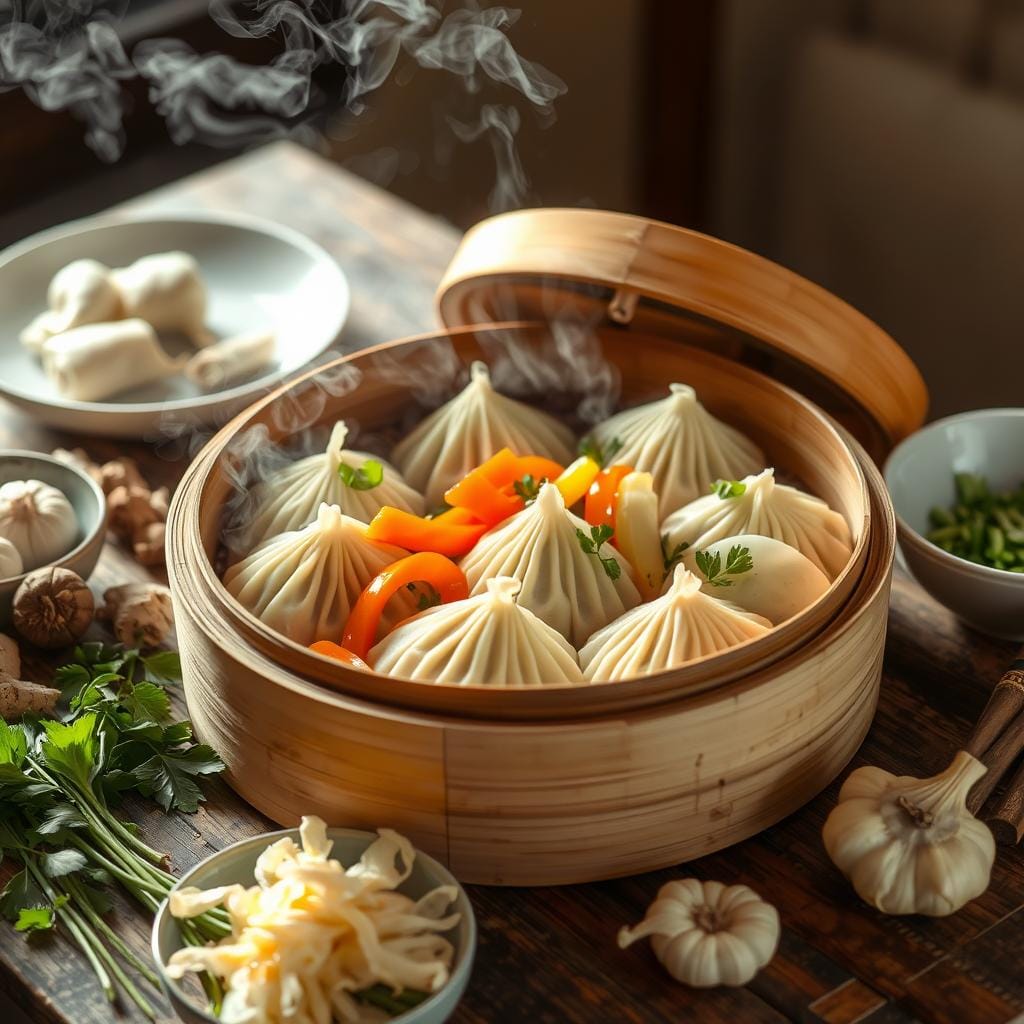Table of Contents
Ever thought of making your home cooking taste like a restaurant’s with one tool? The bamboo steamer could be your key to tasty, healthy meals. These meals are full of flavor and good for you.
I fell in love with bamboo steamers while cooking Asian dishes at home. They’re more than just tools; they’re a way to make meals that are both healthy and delicious. They help you cook like a pro.
This guide will teach you all about using an Asian steamer. You’ll learn about its parts, how to cook with it, and more. You’ll see how this bamboo steamer can change your cooking game.
Key Takeaways
- Bamboo steamers offer a healthy, quick cooking method
- Perfect for preserving nutrients in vegetables and proteins
- Versatile tool for multiple cuisines and dishes
- Easy to use with minimal kitchen equipment
- Lightweight and portable cooking solution
- Environmentally friendly cooking method
What is a Bamboo Steamer?
I’ve found the magic of bamboo steamers, a cooking tool that changes how we cook. These bamboo cooking baskets have been key in Asian cooking for thousands of years. They offer a special way to make tasty meals.
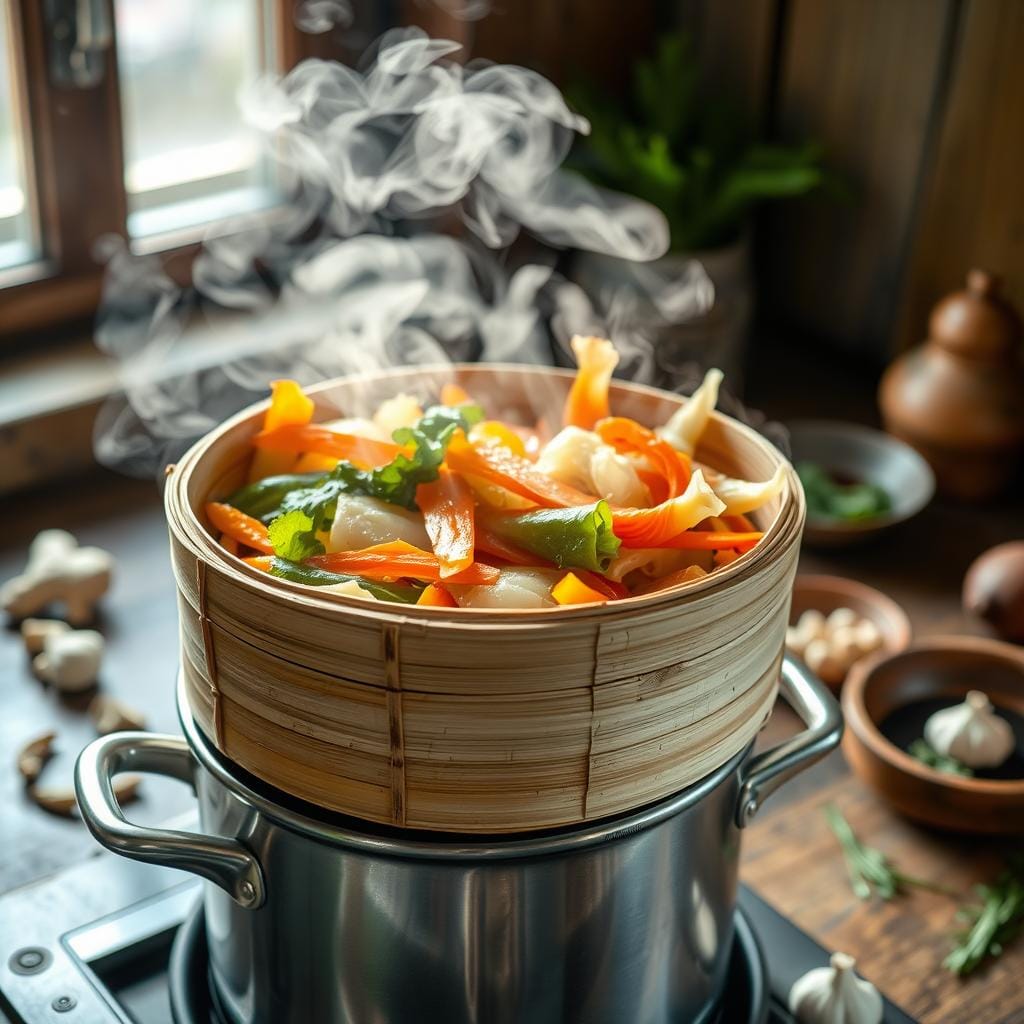
Overview of Bamboo Steamers
A dim sum steamer is more than a tool; it’s a form of cooking art. These steamers have two or more layers that stack, letting you cook many dishes at once. They usually are about 20 cm wide, giving enough room for different foods.
- Designed to fit inside larger pots or pans
- Allows simultaneous cooking of different foods
- Typically made from natural bamboo materials
History of Bamboo Cooking
The history of bamboo steamers goes back to ancient China. Evidence shows they were used as far back as 5000 BC. The design we know today came from the Han dynasty (206 BC – 220 AD) in Southern China, showing centuries of cooking innovation.
Bamboo steamers represent a bridge between ancient cooking traditions and modern culinary practices.
Benefits of Using a Bamboo Steamer
Using a bamboo steamer has many benefits. These kitchen gadgets help keep nutrients in, make flavors better, and are a healthier choice than frying or boiling.
| Benefit | Description |
|---|---|
| Nutrient Preservation | Steaming keeps vitamins and minerals in food |
| Flavor Enhancement | Natural bamboo adds a subtle aroma |
| Sustainable Cooking | An eco-friendly choice compared to metal or silicone steamers |
Choosing the Right Bamboo Steamer
Finding the right chinese steamer basket can change your cooking game. A wooden steamer is more than a tool; it’s a key to healthier, tastier meals. With many choices, knowing about bamboo steamers is key for home cooks.
Understanding Steamer Sizes and Layers
Bamboo steamers come in various sizes to fit different cooking needs. Most find 10-inch models the most useful. Multi-tier designs add great flexibility:
- Single-tier steamers: Great for individuals or small meals
- Two-tier steamers: Best for families and varied meals
- Three-tier steamers: Perfect for big groups or cooking in bulk
Where to Purchase Quality Steamers
Looking for a good bamboo steamer means smart shopping. Visit specialized kitchen stores and trusted online sites. Joyce Chen and Prime Home Direct are top choices.
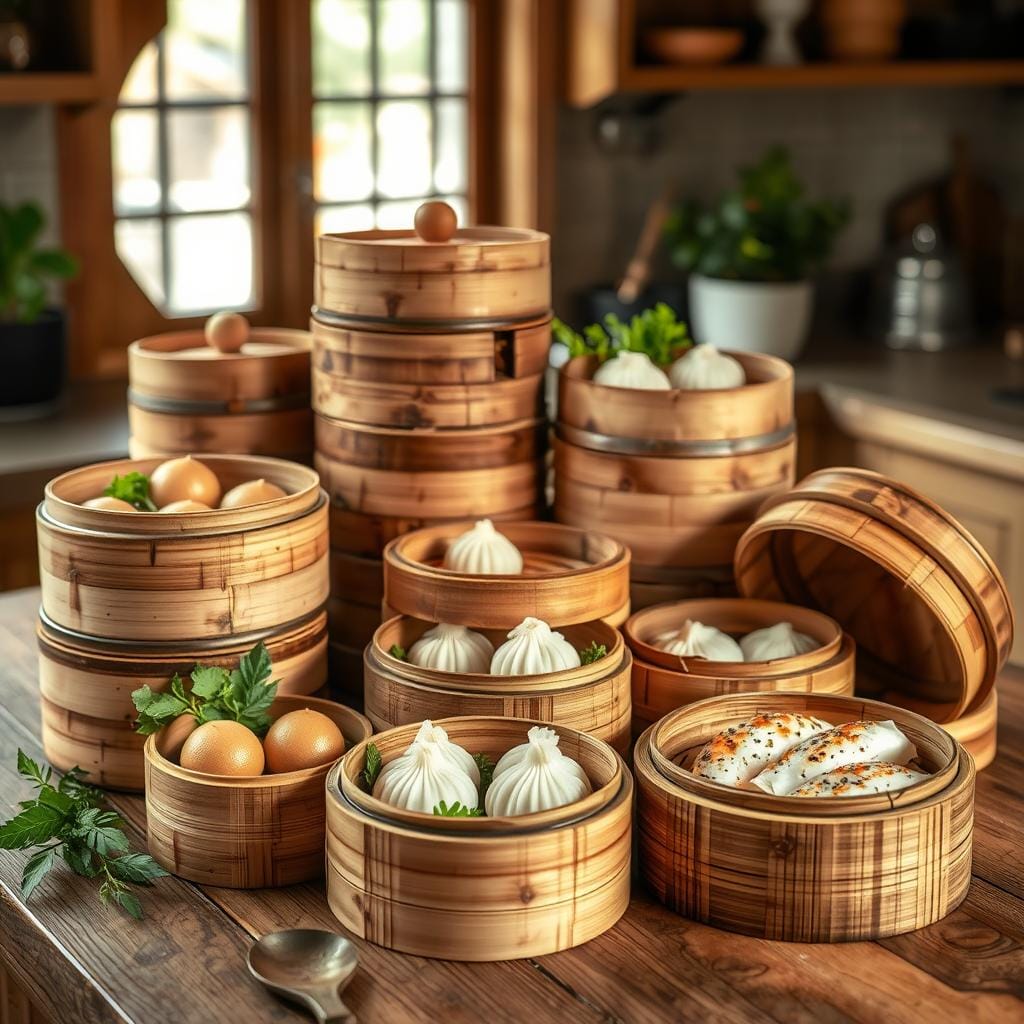
Selection Tips for the Best Steamer
| Feature | What to Look For |
|---|---|
| Material Quality | 100% natural bamboo, tight weave |
| Size | 10-12 inches recommended |
| Construction | Smooth edges, no loose bamboo strands |
| Additional Features | Silicone liners, included accessories |
“A great bamboo steamer is an investment in delicious, nutritious cooking.” – Culinary Expert
Pro tip: Check your steamer well before buying. Look for tight weave, smooth build, and no damage signs. Quality is more important than price when picking your cooking partner.
Preparing Your Bamboo Steamer for Use
Getting your bamboo steamer ready for use is important. It’s not just a cooking tool. It’s a delicate piece that needs care to work well and last long.
Initial Cleaning Process
Before you start cooking, clean your steamer well. Here’s how:
- Rinse the bamboo steamer with lukewarm water
- Use a soft brush to remove any loose particles
- Avoid using harsh detergents that might damage the bamboo
- Air dry completely for 24 hours
Seasoning Your Steamer
Seasoning keeps food from sticking and protects the bamboo. Here’s what to do:
- Brush a light layer of vegetable oil on the steamer’s surface
- Allow the oil to absorb naturally
- Repeat this process 2-3 times before first use
Damage Inspection Checklist
| Inspection Area | What to Look For |
|---|---|
| Bamboo Strips | No significant cracks or splits |
| Binding | Tight and secure connections |
| Overall Structure | Even and symmetrical shape |
“A well-maintained bamboo steamer can last 5-10 years with proper care.” – Culinary Experts
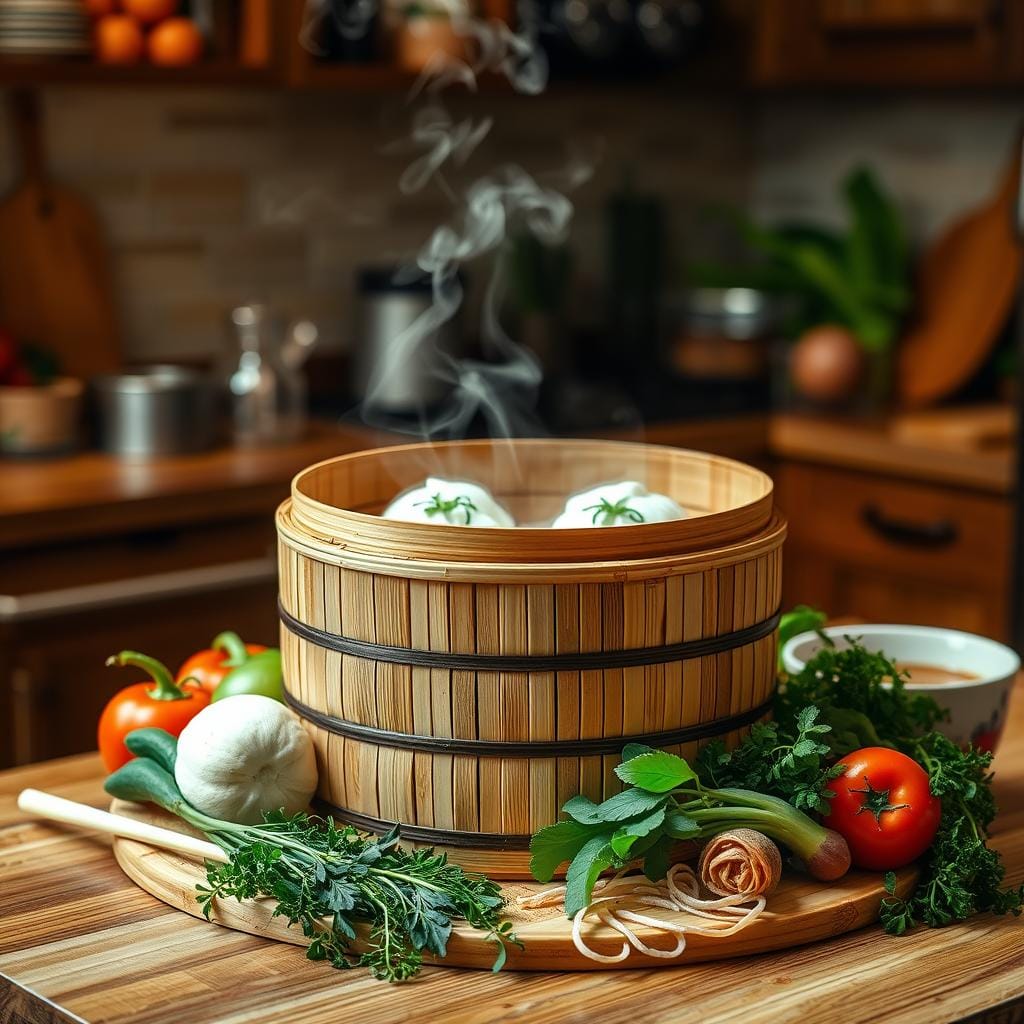
Pro tip: Always inspect your steamer carefully before each use to ensure safe and effective cooking.
Basic Cooking Techniques with a Bamboo Steamer
Learning to use a bamboo steamer can make cooking healthier and tastier. I’ll show you key techniques to boost your cooking skills with a bamboo steamer.
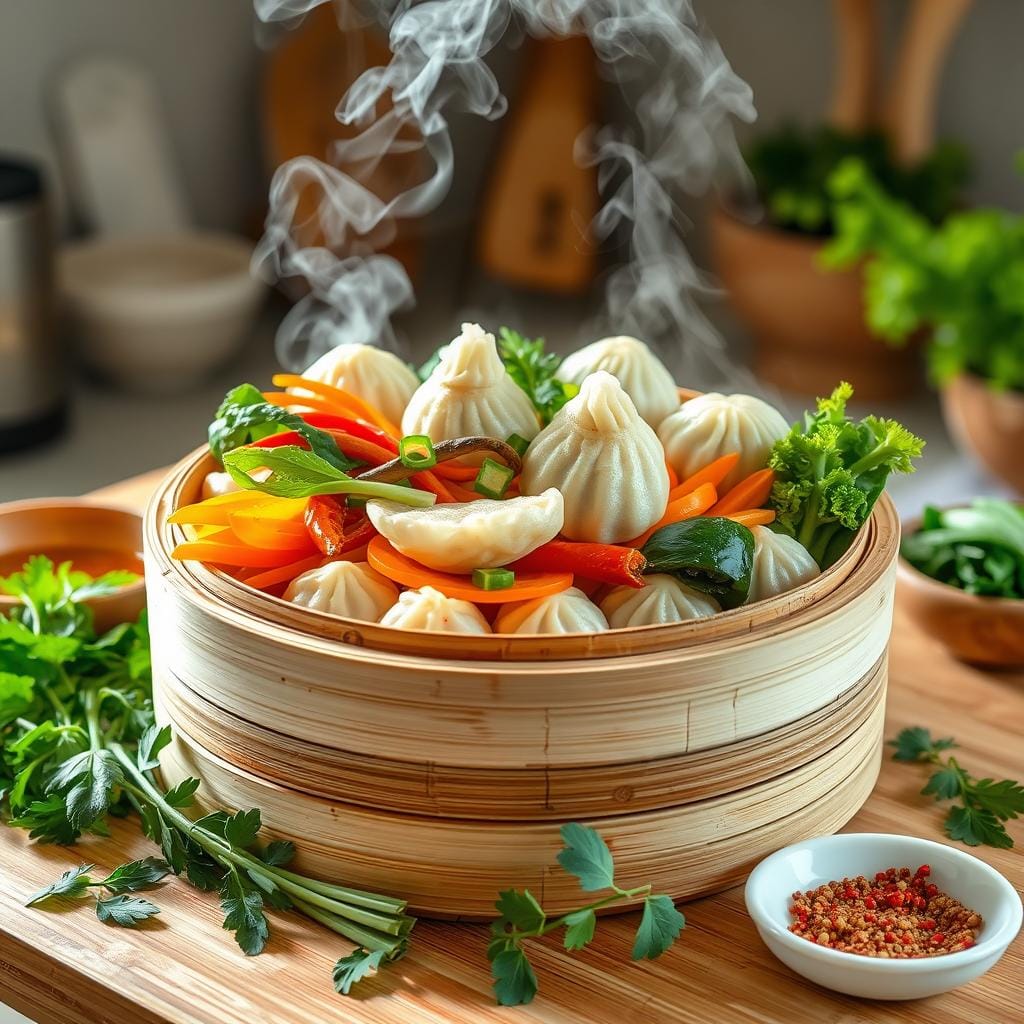
Steaming Vegetables
Steaming veggies keeps nutrients in and makes them crunchy. Here are my top picks:
- Cut veggies into equal sizes for even cooking
- Steam for 10-15 minutes
- Best veggies for steaming:
- Broccoli
- Green beans
- Asparagus
- Shiitake mushrooms
Cooking Seafood
Steaming seafood needs care to keep flavors delicate. Here’s how to do it right:
| Seafood Type | Steaming Time | Tips |
|---|---|---|
| Fish Fillets | 6-8 minutes | Season with ginger and scallions |
| Shrimp | 3-4 minutes | Arrange in single layer |
| Shellfish | 5-7 minutes | Check for opaque coloration |
Preparing Dumplings
Dumplings are a favorite for steaming. Here’s how to make them perfectly:
- Line steamer with cabbage leaves or parchment paper
- Place dumplings with 1-inch gaps between them
- Steam for 11 minutes
- Let rest covered for 1 minute
- Uncover and rest for another minute before serving
Pro tip: Make sure your steamer is wet before use to avoid burning.
With these tips, you’ll be a pro at bamboo steaming in no time!
Creative Recipes to Try
Exploring new culinary techniques can transform your kitchen experience. A bamboo steamer opens up a world of delicious possibilities. It allows you to create authentic Asian dishes with ease and precision.
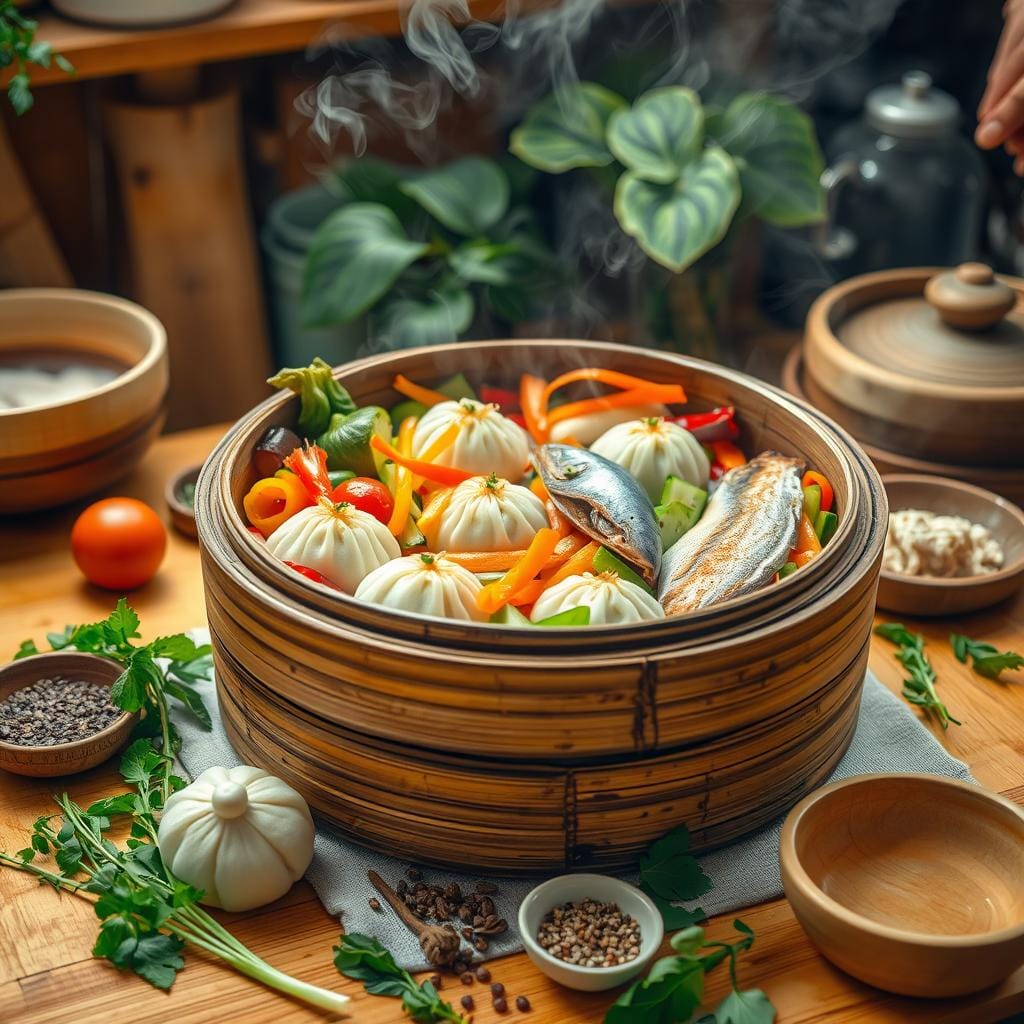
Classic Asian Dumplings
Dumplings represent the heart of Asian steamer cuisine. I’ll share a simple method for creating delectable pockets of flavor using your bamboo steamer. Different styles of dumplings work perfectly in this cooking method:
- Jiaozi: Traditional Chinese dumplings with meat or vegetable fillings
- Shumai: Open-topped delicate dumplings
- Har gow: Translucent shrimp dumplings
- Fun quo: Rice flour wrapped dumplings
Steamed Fish with Herbs
Steaming fish in a bamboo steamer preserves delicate flavors and nutrients. I recommend using fresh herbs like cilantro, ginger, and green onions to create an aromatic dish. The asian steamer allows gentle cooking that keeps fish tender and moist.
Vegetable Medley
Maximize your bamboo steamer’s full capacity by preparing a colorful vegetable mix. Quick cooking times help retain nutrients and vibrant colors. Consider these combination tips:
- Cut vegetables into uniform sizes
- Layer firmer vegetables at the bottom
- Steam for 2-3 minutes for crisp texture
“A bamboo steamer transforms simple ingredients into extraordinary meals.” – Chef’s Wisdom
Each recipe shows the incredible versatility of your bamboo steamer. It makes healthy and delicious cooking accessible to everyone.
Using Your Bamboo Steamer Efficiently
Learning to use a bamboo cooking basket is key to making great meals. It’s all about being efficient. This way, you can cook delicious food with less effort.
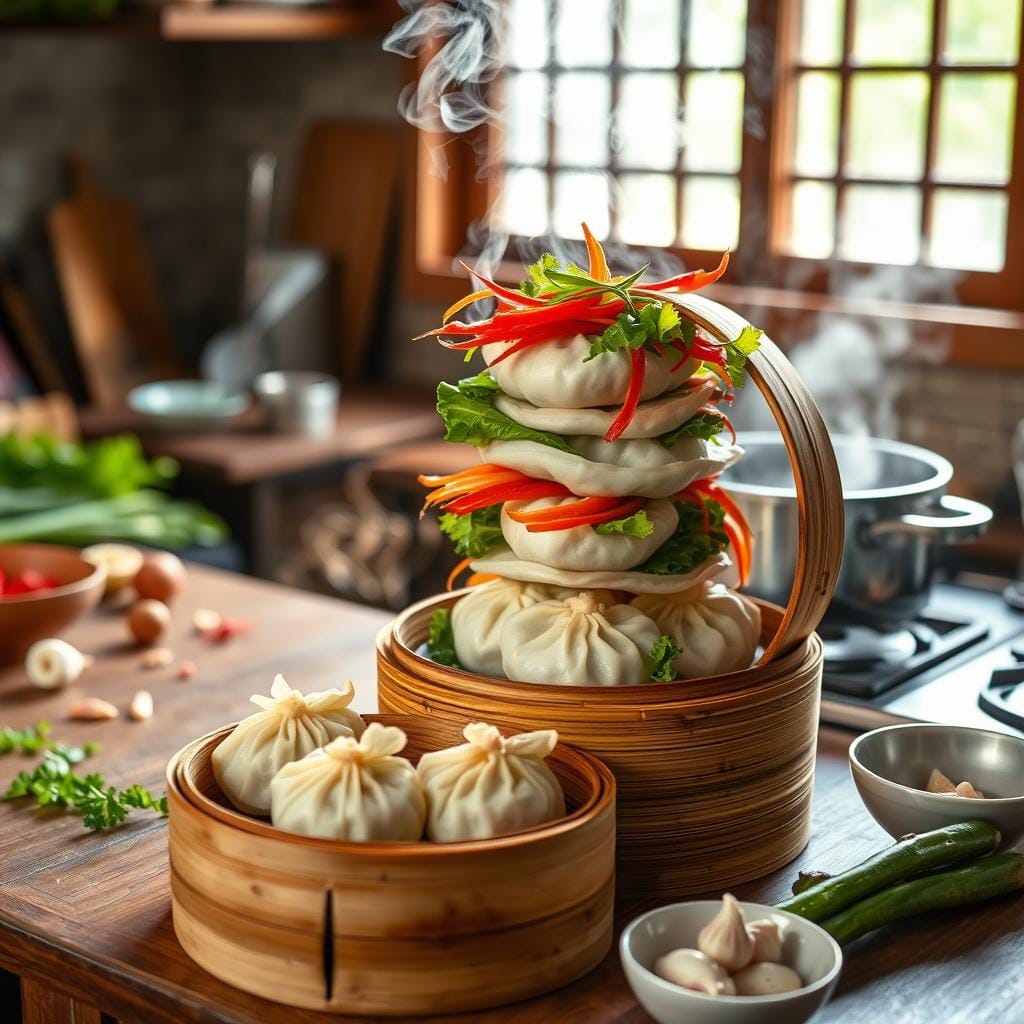
Using a bamboo steamer can change how you cook. Here are some tips to help you cook better:
Multi-Layer Steaming Strategies
- Stack multiple bamboo steamer baskets to cook different foods at once
- Put denser veggies on the bottom and quicker-cooking items on top
- Arrange foods by cooking time for even cooking
Precise Cooking Timing
Knowing how long to steam is important for perfect food. Each ingredient steams differently:
| Food Type | Steaming Time |
|---|---|
| Root Vegetables | 15-20 minutes |
| Proteins (Chicken) | 10-15 minutes |
| Delicate Vegetables | 5-10 minutes |
Avoiding Common Mistakes
To avoid problems with your steamer, follow these tips:
- Keep about one inch of liquid in the pot
- Use nonstick spray for foods that stick
- Don’t overcrowd the steamer basket
- Make sure there’s air between food items
“Efficiency in steaming is about understanding your ingredients and respecting their unique cooking requirements.”
By using these methods, your bamboo steamer will become a valuable kitchen tool. It will save you time and keep your food nutritious.
Complementary Ingredients for Steaming
Steaming turns simple ingredients into amazing dishes. Using a chinese steamer basket or wooden steamer, the right seasonings and sides can make your meals stand out.
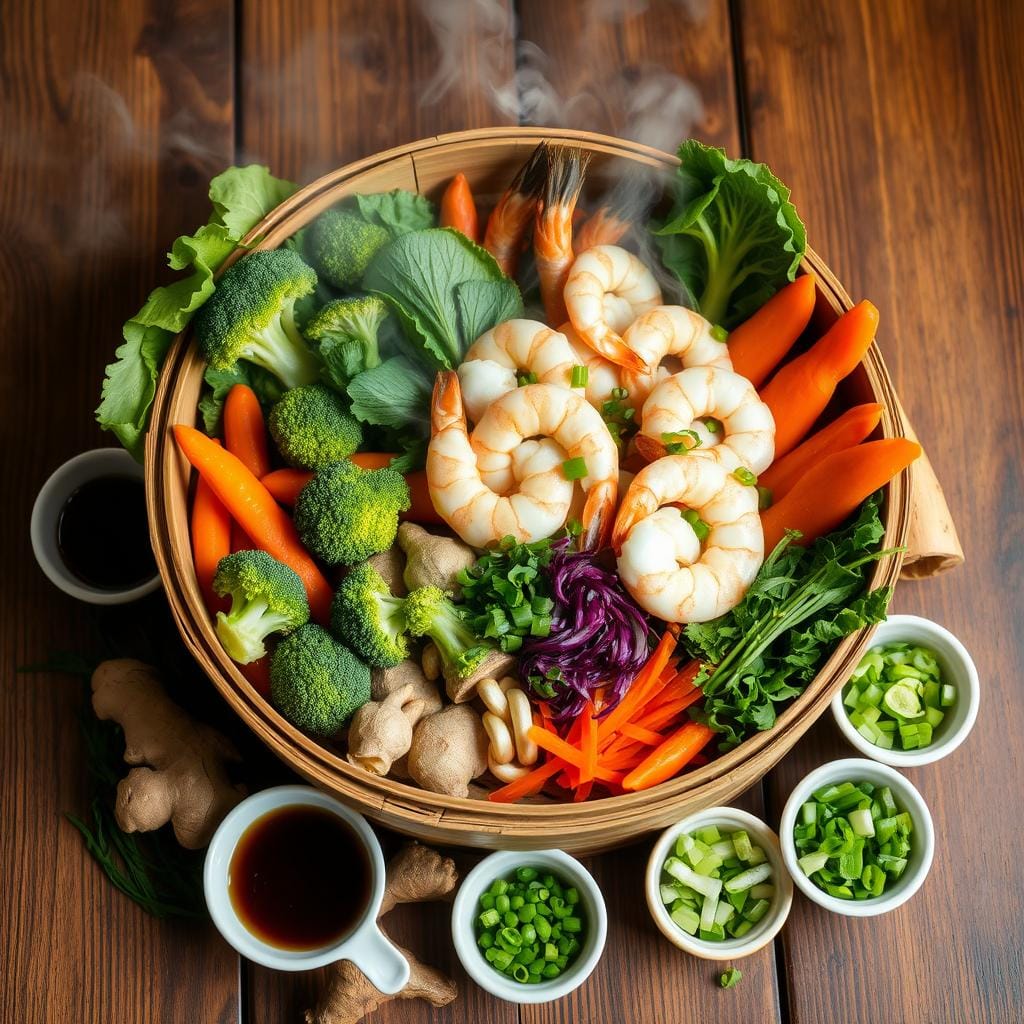
Choosing the right ingredients is key to a great steamed dish. Here are some tips for creating unforgettable flavors in your steamed food.
Seasoning Ideas for Maximum Flavor
- Fresh ginger: Adds warmth and depth to steamed proteins
- Garlic: Provides a robust, aromatic base for many dishes
- Green onions: Brings a light, fresh note to steamed ingredients
- Shaoxing wine: Introduces a complex, slightly sweet undertone
Suggested Accompaniments
When cooking in your wooden steamer, try these ingredients:
- Fresh herbs like cilantro or Thai basil
- Sliced mushrooms
- Tender baby bok choy
- Delicate rice noodles
Pairing with Sauces
A good sauce can make a simple steamed dish great. Here are my top picks:
- Soy sauce with sesame oil
- Chili oil with rice vinegar
- Ginger-scallion sauce
- Fermented black bean sauce
“The secret to great steaming is balance – letting each ingredient shine while creating harmony on the plate.”
For dumplings, aim for a 70% meat to 30% fat mix. Tiger prawns can add flavor. Make sure to wrap them well for perfect steaming. Each dumpling has about 332 calories, making it a healthy choice.
Maintenance and Care for Your Bamboo Steamer
Keeping your bamboo steamer in good shape is important. It can last for years if you take care of it. This means you’ll get to enjoy healthy meals easily.
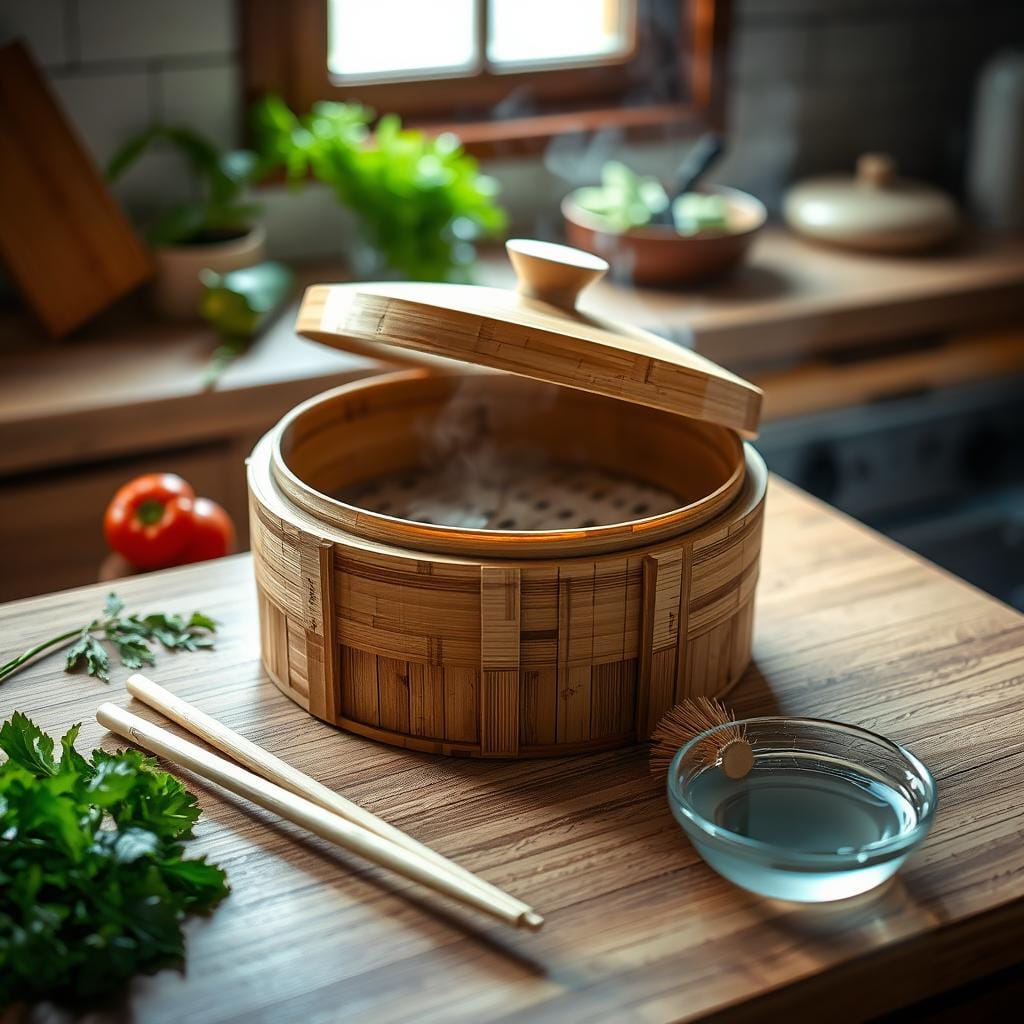
There are a few key steps to keep your bamboo steamer working well. Here are my best tips for taking care of this kitchen tool.
Cleaning Essentials
After each use, clean your bamboo steamer gently but thoroughly. Here are some important cleaning tips:
- Rinse with warm water right after use
- Use a soft brush to get rid of food bits
- Stay away from harsh cleaners or rough sponges
- Don’t soak the steamer in water
Effective Drying Techniques
Moisture is bad for bamboo steamers. Proper drying can stop mold and make your steamer last up to 30% longer. Here’s how to dry it right:
- Let it air dry for 48 hours
- Put it in a place with good air flow
- Don’t store it in humid areas
Storage and Protection
“Treat your bamboo steamer like a treasured kitchen companion, and it will serve you well for years.”
Where you store your steamer is key. Keep it in a cool, dry spot, away from sunlight. A little food-safe mineral oil every few months can keep the bamboo moist and prevent it from cracking.
Minor Repair Strategies
Small problems can often be fixed at home. For loose weaves or small cracks, a little care and some basic fixes can make your steamer last longer.
By following these care tips, your bamboo steamer will stay a reliable and clean cooking tool for many meals.
Bamboo Steamer vs. Other Steaming Methods
Steaming cookware has changed a lot over time. Bamboo steamers are a standout tool. They offer benefits that metal and electric steamers can’t match.
Material Matters in Cooking
Natural materials like bamboo add special qualities to cooking. Bamboo steamers are great because:
- They soak up extra moisture
- They add a unique flavor to food
- They are good for the environment
- They are biodegradable and sustainable
Comparing Steaming Technologies
| Steamer Type | Cost Range | Cooking Efficiency | Environmental Impact |
|---|---|---|---|
| Bamboo Steamer | $15-$30 | High flavor retention | Extremely Low |
| Metal Steamer | $40-$80 | Medium flavor retention | Moderate |
| Electric Steamer | $50-$160 | Consistent cooking | High |
Why Natural Materials Shine
Bamboo steamers have special benefits. They keep up to 90% of food’s nutritional value. Boiling can lose over 50% of vitamins and minerals.
Bamboo steamers aren’t just cookware – they’re a connection to centuries-old culinary traditions.
Bamboo grows fast, up to 91 cm in a day. It’s a great choice for chefs who care about the environment. Learn more at this link.
Understanding Steaming Sustainability
Sustainability is key in today’s kitchens, and bamboo steamers lead the way. These Asian steamers do more than cook food. They show we care about the planet and how we prepare food.
Eco-Friendly Aspects of Bamboo
Bamboo is a standout for its green credentials. It grows fast and needs little to grow. Here are some cool facts about bamboo:
- Bamboo grows up to 3 feet per day
- No pesticides or fertilizers are needed for cultivation
- Bamboo absorbs more carbon dioxide than most trees
- Renewable harvest cycle of just 3-5 years
Reducing Kitchen Waste
An Asian steamer cuts down kitchen waste. It steams food, keeping nutrients in and using less oil. Choosing a bamboo steamer means you’re choosing health and the planet.
| Sustainability Benefit | Impact |
|---|---|
| Nutrient Retention | Up to 90% nutrients preserved |
| Water Usage | Minimal water required |
| Energy Consumption | Lower compared to traditional cooking methods |
Supporting Local Crafts
Buying a bamboo steamer is more than just getting a tool. It’s supporting local crafts. Many are made by skilled artisans who have honed their craft for years.
“Sustainable cooking begins with conscious choices about our kitchen tools.”
Choosing a bamboo steamer is a green choice. It supports sustainable farming, cuts down on waste, and keeps traditional cooking alive.
Troubleshooting Common Bamboo Steamer Issues
Cooking with a bamboo steamer can sometimes present challenges. But knowing how to address common problems will help you become a confident dim sum steamer expert. Let’s explore the most frequent issues and their practical solutions.
Preventing Food from Sticking
Food sticking is a common frustration when using a bamboo steamer. To prevent this, I recommend several effective strategies:
- Line the bamboo steamer with parchment paper
- Use cabbage leaves as a natural non-stick barrier
- Lightly oil the steamer surface
- Ensure proper spacing between food items
Cooking oils like sunflower or canola can be used to lightly grease the steaming basket. Pro tip: Cut parchment paper to match the exact size of your dim sum steamer for optimal steam circulation.
Managing Steam Levels
Controlling steam is key for perfect cooking. Here’s a quick reference guide for steam management:
| Food Type | Water Depth | Cooking Time | Heat Setting |
|---|---|---|---|
| Vegetables | 1-2 inches | 5-7 minutes | Medium (4-6) |
| Fish | 1-2 inches | 10-15 minutes | Medium-High (5-7) |
| Meat | 1-2 inches | 25-30 minutes | Medium-High (5-7) |
Addressing Odor and Maintenance
Bamboo steamers can develop odors if not properly maintained. Here are some cleaning techniques:
- Use a vinegar solution (1 part vinegar, 2 parts water) for 30 minutes
- Apply a 5% alcohol solution for stubborn spots
- Air dry completely after each use
- Store in a dry, well-ventilated area
“A well-maintained bamboo steamer is the secret to consistently delicious meals.” – Culinary Expert
By following these tips, you’ll master the art of using your bamboo cooking basket. You’ll create delectable dim sum steamer dishes with confidence.
Serving Suggestions Post-Steaming
Mastering the chinese steamer basket opens up new ways to serve food. It’s not just for cooking. It’s a tool for making meals look as good as they taste.
Elegant Presentation Techniques
Turn your steamed dishes into stunning visuals. Here are some tips:
- Keep steamed items in their original chinese steamer basket for rustic charm
- Use white ceramic plates to highlight the natural colors of steamed foods
- Garnish with fresh herbs like cilantro or green onions
- Create height by stacking different components
Creative Dining Experiences
Make steaming a fun, interactive meal. Use your wooden steamer as a centerpiece. Guests can pick their favorite steamed foods right from the basket.
| Dish Type | Recommended Garnish | Serving Style |
|---|---|---|
| Dumplings | Chili oil, sesame seeds | Family-style shared platter |
| Seafood | Lemon wedges, fresh dill | Individual elegant plates |
| Vegetables | Soy sauce, toasted sesame seeds | Communal wooden board |
Plating Steamed Masterpieces
When plating, keep it simple. Let the natural beauty of your ingredients shine. A little sauce, some herbs, or a neat arrangement can make a simple meal special.
By focusing on presentation, your steamed dishes will impress. They’ll not only taste great but also look amazing. This creates unforgettable dining moments that highlight your chinese steamer basket’s versatility.
Frequently Asked Questions About Bamboo Steamers
Bamboo steamers are versatile kitchen tools that spark curiosity among home cooks. As a food steamer enthusiast, I’ve compiled the most common questions to help you master your vegetable steamer techniques.
How Do I Know When Food is Done?
Determining doneness is key when using a food steamer. For dumplings, use the toothpick test: insert a toothpick into the center. If it comes out clean and hot, your dish is ready. With vegetables, look for a bright color and tender texture. Seafood should be opaque and flake easily.
- Check dumplings with a toothpick
- Vegetables should be vibrant and soft
- Seafood must be opaque and flaky
Can I Use a Bamboo Steamer on an Electric Stove?
Electric stoves require a bit of creativity with bamboo steamers. I recommend using a flat-bottomed wok ring or a metal trivet to elevate the steamer. Ensure your steamer fits securely and doesn’t wobble. Some electric stove users also invest in a specialized steamer stand for optimal stability.
Are Bamboo Steamers Dishwasher Safe?
Bamboo steamers demand gentle care. Hand washing is always recommended to preserve the natural wood material. Avoid soaking for extended periods and dry thoroughly after cleaning to prevent mold. The Kitchen Craft World of Flavours Bamboo Steamer, with its 4.4-star rating, suggests careful maintenance to extend your steamer’s lifespan.
“Treat your bamboo steamer like a cherished kitchen companion, and it will serve you delicious meals for years.”
With proper care and understanding, your bamboo steamer can become an indispensable tool in creating healthy, flavorful meals.
Personal Experiences with Bamboo Steaming
My journey with bamboo steamers started by chance. I was drawn to their simplicity and versatility. They changed how I cook, making meals healthier and more eco-friendly.
What I Love About Cooking This Way
Steaming cookware is amazing because it keeps nutrients in and makes food taste great. My bamboo steamer can cook everything from frozen dumplings to steamed broccoli. It’s great because I can cook many things at once, saving time and energy.
Lessons Learned in Steaming
Looking after a bamboo steamer needs patience and care. I learned to air dry it for 24 hours after cleaning to avoid mold. Also, a thin layer of vegetable oil keeps it from cracking. It’s more than just a tool; it connects me to traditional cooking.
My Favorite Bamboo Steamer Moments
My favorite moments are when I experiment with my bamboo steamer. Whether it’s making dumplings or a big meal, it’s always a joy. It makes cooking healthy and sustainable, inspiring me every time.
FAQ
How do I know when food is properly cooked in a bamboo steamer?
Can I use a bamboo steamer on an electric stove?
Are bamboo steamers dishwasher safe?
How often should I replace my bamboo steamer?
Can I stack multiple bamboo steamers?
How do I prevent food from sticking to the bamboo steamer?
What’s the best way to store a bamboo steamer?
Source Links
- How to Use a Bamboo Steamer
- 15 Minute Bamboo Basket Steamed Salmon with Lemon and Fennel
- Bamboo steamer
- How to Use a Bamboo Steamer
- Best Bamboo Steamer Basket: Stylish Steaming In 2024! | 86 Lemons
- The best dumpling steamers to buy (and how to use them)
- Use a Bamboo Steamer for Easy, Healthy, and Super Tasty Meals
- How to Use a Bamboo Steamer
- Chinese Dumpling Steamer Baskets
- 5 Reasons to Choose Bamboo Steamers for Cooking
- How to Use a Bamboo Steamer
- Steamed Vegetables Using a Bamboo Steamer
- Best Bamboo Steamer Recipes To Elevate Your Home Cooking
- How to Use a Bamboo Steamer
- Steamed Bao Buns – Love and Lemons
- Why You Should Use a Steamer Basket to Cook Everything From Green Beans to Shrimp
- The Ultimate Guide To Momo Steamers: Your Perfect Tool For Delicious Dumplings – Momo Delights
- The Ultimate Guide: How to Use a Bamboo Steamer for Healthy Cooking
- Steamed Dumplings (with Pork and Shrimp) – Rasa Malaysia
- 20 Steamed Recipes That Will Change The Way You Cook Forever
- How To Clean A Bamboo Steamer?
- How to Clean a Bamboo Steamer: Step-by-Step Guide
- The Best Food Steamers for Every Type of Cook
- The Best Food Steamers to Cook Meat, Veggies, and More
- 5 Reasons to Choose Bamboo Steamers for Cooking
- How to Use a Bamboo Steamer
- 5 Reasons to Choose Bamboo Steamers for Cooking
- How to Get Rid of Mold on Your Bamboo Steamer?
- How Do You Keep Dumplings From Sticking to the Basket in a Steamer – Cook Like Czechs
- How to Use a Steamer Basket (Plus Cooking Times)
- January 1st.
- The Art of Steaming Couscous
- Steamed Chinese Dumplings Recipe
- Bamboo Steamer
- Best Bamboo Steamers: 5 Top Picks for Dumplings, Veggies & More
- How to Use a Bamboo Steamer
- How To Clean A Bamboo Steamer?
- How Does A Bamboo Steamer Basket Work? – The Daily Meal

